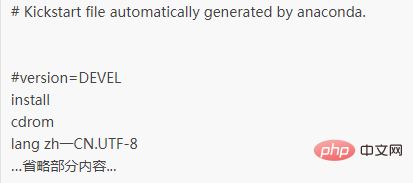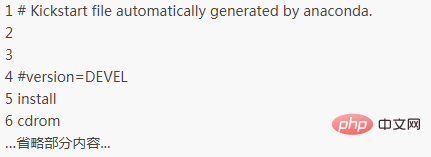What does linux cat mean?
In Linux, the full name of cat is "concatenate", which means "connection". It can be used to connect files and print to the standard output device. The cat command can display the contents of a specified file or connect several files for display; the syntax is "cat [option] file name" or "cat file 1 file 2 > file 3".

#The operating environment of this tutorial: CentOS 6 system, Dell G3 computer.
In Linux, the full name of cat is "concatenate", which means "connection".

# The cat command is used to connect files and print to the standard output device. This command is often used to display the contents of a file, or to connect several files for display, or to read the content from the standard input and display it. It is often used in conjunction with the redirection symbol.
The cat command can be used to display the contents of a text file (similar to the type command under DOS), or to append the contents of several files to another file, that is, to connect and merge files. The basic format of the
cat command is as follows:
cat [选项] 文件名
or
cat 文件1 文件2 > 文件3
. Of the two formats, the former is used to display the contents of the file. Common options and their respective meanings are as shown in the table. 1; the latter is used to join merged files.
| Options | Meaning |
|---|---|
| is equivalent to the integration of the -vET option, used to list all hidden symbols; | |
| lists the carriage return character at the end of each line $; | |
| Number all lines of output; | |
| Same as Unlike -n, this option means that only non-blank lines will be numbered. | |
| Display the Tab key^I; | |
| List Special characters; | |
| When encountering more than 2 consecutive blank lines, they will be replaced with 1 blank line. |
PgUp up arrow key combination to page up, but this page turning has its limits. If the file is long enough, you still cannot view the entire file content.
[root@localhost ~]# cat anaconda-ks.cfg

-n" option, the line number will be displayed. For example:
[root@localhost ~]# cat -n anaconda-ks.cfg

[root@localhost ~]# cat -A anaconda-ks.cfg
[root@localhost base]# ls file1.txt file2.txt [root@localhost base]# cat file1.txt http://c.biancheng.net(file1.txt) [root@localhost base]# cat file2.txt is great(file2.txt) [root@localhost base]# cat file1.txt file2.txt > file3.txt [root@localhost base]# more file3.txt #more 命令可查看文件中的内容 http://c.biancheng.net(file1.txt) is great(file2.txt) [root@localhost base]# ls file1.txt file2.txt file3.txt
Linux Video Tutorial"
The above is the detailed content of What does linux cat mean?. For more information, please follow other related articles on the PHP Chinese website!

Hot AI Tools

Undresser.AI Undress
AI-powered app for creating realistic nude photos

AI Clothes Remover
Online AI tool for removing clothes from photos.

Undress AI Tool
Undress images for free

Clothoff.io
AI clothes remover

AI Hentai Generator
Generate AI Hentai for free.

Hot Article

Hot Tools

Notepad++7.3.1
Easy-to-use and free code editor

SublimeText3 Chinese version
Chinese version, very easy to use

Zend Studio 13.0.1
Powerful PHP integrated development environment

Dreamweaver CS6
Visual web development tools

SublimeText3 Mac version
God-level code editing software (SublimeText3)

Hot Topics
 1378
1378
 52
52
 Difference between centos and ubuntu
Apr 14, 2025 pm 09:09 PM
Difference between centos and ubuntu
Apr 14, 2025 pm 09:09 PM
The key differences between CentOS and Ubuntu are: origin (CentOS originates from Red Hat, for enterprises; Ubuntu originates from Debian, for individuals), package management (CentOS uses yum, focusing on stability; Ubuntu uses apt, for high update frequency), support cycle (CentOS provides 10 years of support, Ubuntu provides 5 years of LTS support), community support (CentOS focuses on stability, Ubuntu provides a wide range of tutorials and documents), uses (CentOS is biased towards servers, Ubuntu is suitable for servers and desktops), other differences include installation simplicity (CentOS is thin)
 Centos stops maintenance 2024
Apr 14, 2025 pm 08:39 PM
Centos stops maintenance 2024
Apr 14, 2025 pm 08:39 PM
CentOS will be shut down in 2024 because its upstream distribution, RHEL 8, has been shut down. This shutdown will affect the CentOS 8 system, preventing it from continuing to receive updates. Users should plan for migration, and recommended options include CentOS Stream, AlmaLinux, and Rocky Linux to keep the system safe and stable.
 Detailed explanation of docker principle
Apr 14, 2025 pm 11:57 PM
Detailed explanation of docker principle
Apr 14, 2025 pm 11:57 PM
Docker uses Linux kernel features to provide an efficient and isolated application running environment. Its working principle is as follows: 1. The mirror is used as a read-only template, which contains everything you need to run the application; 2. The Union File System (UnionFS) stacks multiple file systems, only storing the differences, saving space and speeding up; 3. The daemon manages the mirrors and containers, and the client uses them for interaction; 4. Namespaces and cgroups implement container isolation and resource limitations; 5. Multiple network modes support container interconnection. Only by understanding these core concepts can you better utilize Docker.
 How to use docker desktop
Apr 15, 2025 am 11:45 AM
How to use docker desktop
Apr 15, 2025 am 11:45 AM
How to use Docker Desktop? Docker Desktop is a tool for running Docker containers on local machines. The steps to use include: 1. Install Docker Desktop; 2. Start Docker Desktop; 3. Create Docker image (using Dockerfile); 4. Build Docker image (using docker build); 5. Run Docker container (using docker run).
 How to install centos
Apr 14, 2025 pm 09:03 PM
How to install centos
Apr 14, 2025 pm 09:03 PM
CentOS installation steps: Download the ISO image and burn bootable media; boot and select the installation source; select the language and keyboard layout; configure the network; partition the hard disk; set the system clock; create the root user; select the software package; start the installation; restart and boot from the hard disk after the installation is completed.
 What are the backup methods for GitLab on CentOS
Apr 14, 2025 pm 05:33 PM
What are the backup methods for GitLab on CentOS
Apr 14, 2025 pm 05:33 PM
Backup and Recovery Policy of GitLab under CentOS System In order to ensure data security and recoverability, GitLab on CentOS provides a variety of backup methods. This article will introduce several common backup methods, configuration parameters and recovery processes in detail to help you establish a complete GitLab backup and recovery strategy. 1. Manual backup Use the gitlab-rakegitlab:backup:create command to execute manual backup. This command backs up key information such as GitLab repository, database, users, user groups, keys, and permissions. The default backup file is stored in the /var/opt/gitlab/backups directory. You can modify /etc/gitlab
 How to mount hard disk in centos
Apr 14, 2025 pm 08:15 PM
How to mount hard disk in centos
Apr 14, 2025 pm 08:15 PM
CentOS hard disk mount is divided into the following steps: determine the hard disk device name (/dev/sdX); create a mount point (it is recommended to use /mnt/newdisk); execute the mount command (mount /dev/sdX1 /mnt/newdisk); edit the /etc/fstab file to add a permanent mount configuration; use the umount command to uninstall the device to ensure that no process uses the device.
 What to do after centos stops maintenance
Apr 14, 2025 pm 08:48 PM
What to do after centos stops maintenance
Apr 14, 2025 pm 08:48 PM
After CentOS is stopped, users can take the following measures to deal with it: Select a compatible distribution: such as AlmaLinux, Rocky Linux, and CentOS Stream. Migrate to commercial distributions: such as Red Hat Enterprise Linux, Oracle Linux. Upgrade to CentOS 9 Stream: Rolling distribution, providing the latest technology. Select other Linux distributions: such as Ubuntu, Debian. Evaluate other options such as containers, virtual machines, or cloud platforms.





